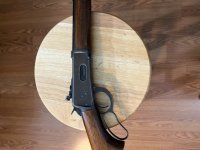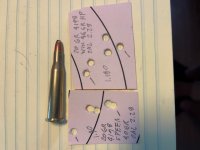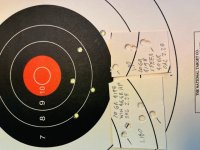This past April in Tulsa I happened upon a reasonably priced Winchester model 64 in 219 Zipper. Other than the receiver having turned brown and a couple of minor stock dings it is a very nice example that has not been messed with.
As I intended to shoot this rifle making cases was first on the to do list.
I used 30-30 cases as I had some. The process that finally worked was as follows:
1. Anneal the neck and shoulder area of the case.
2. Run the case through a 32-40 full length die. This removes the shoulder and adds taper to the body.
3. Run the case through a 25-35 full length die.
4. Run the case through a 219 Zipper full length die.
5. Trim to length.
I had one WW 219 Zipper case which held 29.9 grains of IMR 4198 when completely full. Formed and trimmed Remington cases held 29.8 grains and Federal cases held 28.3 grains
I tried 40, 45, 46, 50 and 55 grain bullets with IMR 4198, 3031, and 4064 powder. Best results were obtained with 40, 45 and 46 grain bullets. The 50 and 55 grain bullets that I had were Hornady V-Max and the rifle would not stabilize these as they went through the target side ways.
The best loads were 40, 45 and 46 grain bullets with 20 grains of IMR 4198. Accuracy at 50 yards was 1.25" and 3" at 100 yards.
This rifle is fun to shoot as it has no recoil and is accurate enough for my purposes.
As I intended to shoot this rifle making cases was first on the to do list.
I used 30-30 cases as I had some. The process that finally worked was as follows:
1. Anneal the neck and shoulder area of the case.
2. Run the case through a 32-40 full length die. This removes the shoulder and adds taper to the body.
3. Run the case through a 25-35 full length die.
4. Run the case through a 219 Zipper full length die.
5. Trim to length.
I had one WW 219 Zipper case which held 29.9 grains of IMR 4198 when completely full. Formed and trimmed Remington cases held 29.8 grains and Federal cases held 28.3 grains
I tried 40, 45, 46, 50 and 55 grain bullets with IMR 4198, 3031, and 4064 powder. Best results were obtained with 40, 45 and 46 grain bullets. The 50 and 55 grain bullets that I had were Hornady V-Max and the rifle would not stabilize these as they went through the target side ways.
The best loads were 40, 45 and 46 grain bullets with 20 grains of IMR 4198. Accuracy at 50 yards was 1.25" and 3" at 100 yards.
This rifle is fun to shoot as it has no recoil and is accurate enough for my purposes.




